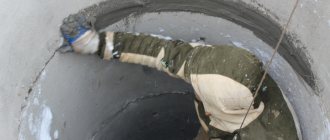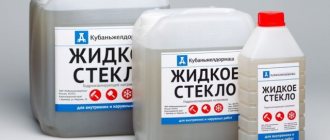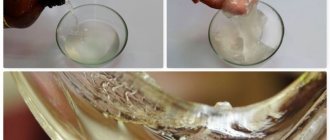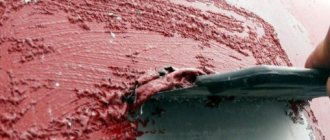It should be said right away that the use of liquid glass for wood is almost on par with the processing of other materials, such as for concrete, hydro- and acid-resistant cement, fabrics, in the production of electrodes, for purifying oils, and so on and so forth.
It can even be used (in combination with alcohol) to make foundry molds for metal products, so this material is quite in demand both in construction and in industry. But we will focus on wood and find out why such processing is needed, and also show you a video in this article.
Meaning of the term
Liquid glass is created by mixing potassium and sodium silicates, with the addition of special plasticizers and modifiers that improve performance properties. After hardening, a transparent layer forms on the surface. After a visual inspection, we can say that the surface is fragile, but this is not the case. Special modifiers penetrate deeply into concrete, which helps protect the building material from moisture and mechanical damage. The cost of liquid glass is significantly lower than that of similar mixtures. Liquid glass is easy to apply, so anyone can handle this procedure.
A building material such as wood is characterized by increased hygroscopicity. Because of this, wood tends to become damp, as a result of which it loses up to half of its actual original strength. Another negative point is that the tree is a fire hazard. In addition, wood is a favorite habitat for a wide variety of insects, mold, fungi and bacteria. For these reasons, it is not advisable to use wooden structures in construction and repairs without proper protection of the material, which includes treatment with liquid glass.
Specifics of working with liquid glass
Real protection from moisture is achieved by covering the silicate adhesive with a layer of 0.1 mm or more. You should first familiarize yourself with the rules for working with a chemical that can lead to individual skin sensitivity, irritation of the respiratory system and thermal injuries to the eyes. That is why safety precautions must be observed when working with this material. Typically used preventatives:
- special work gloves;
- individual mask;
- eye protection glasses;
- overalls
When working, you will need a brush or roller, as well as a grinding tool to pre-clean the surface.
Preparation of wood treatment product
The industry produces primer silicate adhesive in liquid form. The consistency of jelly is considered the norm. The thicker structure of the product will not allow it to be absorbed into the wood - it will simply harden on the surface. As a result, the protective properties of silicate glue are lost. Different manufacturing companies produce a product of varying thickness.
Before use, depending on the initial viscosity, the product is diluted with water according to the instructions: usually two, three or four times. Experienced specialists are able to determine the degree of dilution with great accuracy.
Wood processing process
Priming of wood is carried out in the temperature range from -20 to +40 degrees. To ensure the required thickness of the liquid glass coating (100 microns), there must be at least two layers of the product. The second layer is applied after the first one has completely dried.
The work consists of performing the following steps:
- familiarization with the manual;
- compliance with temperature conditions;
- organization of personal safety;
- leveling the working surface;
- diluting silicate glue with tap water.
Apply diluted sodium silicate to a leveled, sanded surface using a paint roller or a voluminous brush, allow it to dry completely and coat with the product again. If necessary, the procedure should be repeated.
The consumption of the composition is related to the quality of the surface being primed: the better it is polished, the less material is consumed to cover it. On the contrary, for a less smooth flooring, the product cost will increase. The hardening time of liquid glass is determined by the purity of the solution or the additives included in its composition. It ranges from 10 minutes to half a day. Fire retardants contain the most additives.
Attention! Typically, freshly made wood flooring is treated. This increases its durability, preserves the natural shades and visual appeal of the material.
How meaningful is wood processing and how to carry it out?
It is recommended to apply a product such as liquid glass not to everything, but only to those wood structures that are not planned to be painted. The thing is that if a wooden house is treated with silicate glue for protection, it will be almost impossible to paint it.
This is explained by the fact that the wood becomes mirror-smooth and, accordingly, the water-repellent functions increase many times over. It is best to impregnate with the product those wooden structures that are located:
- In the basements.
- On the rooftops.
For example, elements such as beams and rafters. Other places with possible high humidity. If it is necessary to protect wood more productively, liquid glass becomes irrelevant and for this it is necessary to look for other means.
It is important to note the fact that when treating wood with liquid glass, you should ensure that the coating thickness is at least 100 microns. Otherwise, such waterproofing will be of little use.
Surface care
Liquid glass is often used to process wooden panels when making dining tables. When applying LC to countertops, the fiber texture is clearly visible. You can place food on the table; the film is chemically neutral, does not deteriorate from contact with food acids and alkalis, and does not deteriorate from detergents or disinfectant solutions.
The only disadvantage of silicates is that the treated surface cannot be painted. This is explained by the fact that the surface becomes mirror smooth. Adhesion to conventional paints and varnishes is poor; special silicate paints and varnishes have to be used. After treatment, the wood darkens slightly; if you use compounds with additives, you can achieve good decorativeness.
When applying LC to countertops, the fiber texture is clearly visible.
At a low cost, liquid glass has high consumer properties and protects wood from atmospheric influences, microorganisms, insects, and fire. Products from different manufacturers have similar properties, but may differ in the composition of additives. When choosing liquid glass, it is better to purchase products from branded manufacturers.
How is liquid glass produced?
As mentioned earlier, liquid waterproofing is obtained by mixing potassium and sodium with the addition of special substances. Modern technologies make it possible to obtain material in two ways:
- autoclaving of concentrated sodium solution and other silicon-based raw materials;
- fusion of soda and quartz sand.
Some enterprises produce liquid glass by dissolving silicon in an alkaline solution. Depending on the method of production, the material is divided into two types:
- soda glass – has high adhesive properties and is also able to withstand various temperature changes;
- potassium glass - has the same properties as the previous type. However, there is one significant difference - after application to the surface it does not form glare.
It is worth noting that sodium glass is much cheaper than the second type.
Feasibility of wood processing
The use of silicates for wood processing is justified in many cases. Impregnated wood is more durable and fire-resistant, while maintaining decorative properties and the wood texture is clearly visible.
Manufacturers offer a variety of liquid glass for wood; the use of the mixture has been practiced for two centuries. Modern lumber manufacturing technologies do not exclude such additives during the production process. ZhS is used for processing finished wooden buildings made of boards, foundations made of solid wood (solid timber, round timber, sleepers). Novice builders will be able to process wood with liquid glass when constructing private houses, bathhouses, and outbuildings.
In terms of the effectiveness of protecting wood from moisture, liquid glass coatings are superior to films of paints and varnishes; liquid glass is much cheaper and more practical.
Impregnated wood is more durable and fire-resistant, while maintaining decorative properties and the wood texture is clearly visible.
Liquid glass is used to process all kinds of frames and various structures that are subject to intense exposure to negative factors. It is recommended to use silicate mixtures for impregnation:
- Cover crowns;
- Rafters;
- Roof elements;
- Lag for installing the floor;
- Wooden piles;
- grillage;
- Structural elements of wells.
If you treat the walls of basements and cellars, fungus and mold will not develop. The coating is a reliable protection of wood from rotting due to temperature changes and condensation formation. Verandas, terraces and gazebos covered with liquid glass are preserved under the influence of precipitation and ultraviolet radiation. It is recommended to treat places where sewer and water pipes are laid in wooden buildings.
After application to the surface, liquid glass fills unevenness and cracks, and structural stabilization of the wood occurs. A film is formed on the surface that does not allow moisture to pass through.
The coating retains its protective properties for up to 10 years. Then the tree needs to be covered with resin again.
The coating is a reliable protection of wood from rotting due to temperature changes and condensation formation.
The need to protect the tree
Waterproofing impregnation is necessary for any timber used for frames. Without protection, over time, wood loses strength and becomes loose. The tree absorbs moisture vapor from the air, swells, and becomes a breeding ground for fungal spores and mold. Dry air has a detrimental effect: the fibers are compressed, deep cracks and breaks appear in the structure of the timber. The load capacity of structures is significantly reduced.
Another problem is the risk of fire. Fire spreads quickly through untreated wooden frames, and soon the entire structure will be engulfed in flames. When the pores in wood are clogged, oxygen access is limited.
The resulting protective layer is not processed or additionally polished.
Waterproofing impregnation is necessary for any timber used for frames.
We recommend: Dinitrol - protects the WHOLE car from corrosion
Fireproof composition
For construction work, mixtures are produced based on water-soluble silicates of sodium, potassium, and lithium. Also includes:
- Organic silicon compounds;
- Silicic acid in colloidal form;
- Various additives that improve the composition of the mixture.
For fire protection, they purchase LC marked “fire-bioprotection”. The mixture has fire retardant properties and begins to melt at a temperature of 600-650°C. The resulting film is non-flammable, extinguishes flames, reduces wood smoke, and prevents the penetration of oxygen. Organosilicate materials are used for treating internal surfaces in accordance with fire safety rules and instructions. Resinous coniferous trees are more susceptible to fire due to their high hydrocarbon content, while deciduous trees are less dangerous.
ZhS is not used for fire treatment of surfaces for which finishing coating is provided.
Organosilicate materials are used to treat internal surfaces in accordance with fire safety regulations.
Where is liquid glass used?
Not all building materials can be treated with liquid glass. It is used for the following purposes:
- protection of lower floors and basements from groundwater;
- waterproofing of any artificial reservoirs;
- in the production of building compositions that can withstand high temperatures;
- for connecting various building materials;
- to protect walls and ceilings from mold and mildew;
- used for sealing seams;
- necessary when constructing low structures on moving soil.
As for waterproofing, the liquid composition is used as follows:
- surface insulation - the substance fills all pores and cracks, forming reliable protection against moisture and mechanical damage;
- sealing of seams, which prevents water from entering the structure;
- added to concrete to increase strength characteristics.
Important! There is no other substance on the market like liquid glass in terms of composition and cost.
DIY liquid glass
Wood is not able to absorb a thick composition, so the consistency of liquid glass for wood processing should be similar to liquid jelly.
Liquid glass is sold in different consistencies, so it is difficult to offer a single recipe for the composition. Water can make up from 30 to 50% of the composition.
The treatment must be carried out twice. Apply the composition with a brush and let it dry completely. After this, apply the second layer.
Subscribe to our Yandex.Zen channel
Advantages and disadvantages
Any building material has strengths and weaknesses. Scientists have not yet come up with the ideal substance. Knowing the advantages and disadvantages, you can choose the scope of application. In addition, this information attracts many buyers. Liquid glass has the following strengths:
- high adhesion - the substance easily penetrates even the most inaccessible places, thereby strengthening it and protecting it from moisture penetration;
- after hardening, a smooth surface is formed - any type of liquid glass can be applied well to any material, provided that the instructions are followed;
- profitability - when processing building materials, 2 times less liquid glass is used than any other waterproofing composition;
- low cost.
Product selection
The structure, density and cost of the material depend on the method of its production and the components used. According to the most elementary method, the substance is obtained from silicon-containing raw materials combined with an alkaline mixture at certain values of pressure and temperature.
There are several types of liquid glass for dissimilar surfaces. Before choosing a product, you usually get acquainted with its characteristics and determine its suitability for the desired coating. For wood surfaces, sodium silicate adhesive is usually used. You should study the information on the packaging:
- where the products were made;
- shelf life;
- precautionary measures.
Manufacturers
Three samples of the product are optimal for coating wood:
- "Expert" production is a sodium product. It is designed to increase the durability and reliability of wood, protecting it from moisture, mold, mildew, fire and wood-boring insects. The product is non-toxic, does not contain solvents, has no pungent odor, is ready for use - does not require dilution, and can withstand freezing without loss of quality. The time for complete drying at 20 degrees and normal humidity is about a day.
- Translucent liquid glass "Omega" with a sodium composition is produced in the finished form of St. Petersburg. The product is characterized by the absence of solvents. It protects wood well from the effects of negative natural factors and fire.
- An aqueous alkaline solution of sodium silicates from Kubanzheldormash is a viscous light gray liquid. The product provides a durable, light-resistant coating with dirt-repellent and fire-retardant properties.
Sodium silicate is used in areas exposed to aggressive natural factors - outside and inside buildings. Coating wood with liquid glass is effective for extending the life of the material, protecting it from the harmful effects of environmental factors and preserving the appearance of the structure.
However, there are also negative sides:
- any mechanical impact can damage the layer of liquid glass that is applied to the surface;
- cannot be used for waterproofing brick structures;
- hardens quickly, so you have to prepare the composition in small doses and quickly treat the required surface;
- causes difficulties during finishing - it is difficult to paint or varnish the finished surface.
Based on the listed features, we can conclude: liquid glass is best used as an auxiliary material. It will help increase the characteristics of the concrete mixture.
Main characteristics of liquid glass
Liquid glass is an alkaline aqueous solution of potassium or sodium silicates. In some cases they are used in combination. Interestingly, the trade name of this substance is silicate glue. Yes, the same one that everyone is familiar with from labor lessons at school, and that is sold in the office supply store.
When liquid glass hardens, it turns into a transparent mass.
- Liquid glass made on the basis of sodium silicates is highly resistant to various acids. The coating obtained from it is matte, that is, without shine.
- Potassium liquid glass has high adhesive properties. In addition, it has pronounced antiseptic qualities. Therefore, the concrete into which it is added during mixing resists fungal infections and the formation of moss or lichen colonies well. And this can be important, especially when constructing foundations in waterlogged areas.
In appearance, liquid glass is a translucent liquid that may have a yellowish tint. The consistency of the composition depends on the concentration of the main substance. It is diluted with ordinary water.
Liquid glass consists of microscopic crystals, which, when applied to the surface and harden, increase in volume, due to which the mass is able to “seal” small cracks and pores of concrete.
Thanks to this quality of the material, it is able to impart water-repellent and air-tight properties to various surfaces. Liquid glass can be used for flooring in both residential and non-residential premises, as it is an environmentally friendly material.
Liquid glass is sold in plastic transparent or opaque buckets or canisters.
It makes sense to immediately highlight the advantages and disadvantages of this material. Since you need to be familiar with them even before purchasing and planning work.
The advantages of liquid glass include the following:
- The material has water-repellent properties. Therefore, perhaps the main area of its application is reliable waterproofing.
- Antiseptic qualities prevent the occurrence of biological damage to building materials that include liquid glass or are coated with it.
- Antistatic properties allow materials not to accumulate electricity.
- Liquid glass functions as an effective hardener. The material to which a silicate composition is added or applied on top of it receives increased strength characteristics.
- Glass is inert to chemical influences, therefore it can protect any surface from their aggressive influence.
- A positive quality is its resistance to high and low temperatures.
- High penetrating ability allows for good binding of the structure of loose material.
- An affordable price along with high solution consumption makes liquid glass accessible to any consumer.
Liquid glass also has its significant disadvantages :
- First of all, it is incompatible with organic substances and materials containing them.
- The service life of a liquid glass coating is not very impressive, being only about five years. After this time, the silicate film begins to collapse. True, the service life of the coating can be extended by timely painting of the surface.
- Liquid glass is not suitable for coating brick surfaces.
- There are certain difficulties with applying the composition.
Preparation of the solution
Before adding liquid glass, you need to know the amount of cement in the mixture. In addition, the location of application of the finished solution is taken into account. Therefore, it is recommended to use the following proportions:
- for covering walls and ceilings - to prepare a cement-sand mortar, use a ratio of 1:3. In this case, 15% of the total volume of liquid glass is added to the water.
- for artificial reservoirs - liquid glass is mixed with the finished mixture in a ratio of 1:10;
- for wells - the structure will be constantly exposed to moisture, so when preparing the mixture, all components are added in equal doses. Water is added only after thoroughly mixing all components;
- for the production of concrete - the amount of liquid glass should not exceed 3% of the mass of cement. The hardening time depends on the brand of concrete.
The need to protect wood
Timber used in frame buildings and roofing of buildings is characterized by hygroscopicity. They absorb moisture from the air, become damp, mold and gradually lose their strength. The destructiveness of the external environment on wooden structures depends on:
- from increased moisture content in ambient conditions,
- on the amount and volume of precipitation,
- on the rate of decay,
- from the likelihood of fire,
- from exposure to chemicals,
- from wood-boring insects.
The use of liquid glass prevents the adverse effects of dampness and other factors, and extends the service life of wooden structures. It is advisable to use the coating composition in those areas that are most exposed to moisture:
- in basements and office spaces,
- in places where condensation accumulates from heating and ventilation systems,
- in attics where moisture penetrates during rain,
- on floor beams regularly exposed to precipitation.
Liquid glass is not absorbed into wood. When the product is applied to the surface, a protective layer is formed, which serves to waterproof the building material and disinfect it as an antiseptic. This eliminates the likelihood of pathogenic microflora developing in the wood structure and moisture getting inside it.
How to cook at home?
The cooking technology is quite simple. Let's look at the process in more detail:
- Sand and soda are poured into a prepared fireproof container in a ratio of 1:4.
- All components are thoroughly mixed and ground until fine.
- The container is heated to the melting temperature of the components.
- After melting, the formed substance is washed with water.
The main problem is to achieve a constant high temperature inside the container.
Application as waterproofing
Liquid glass is used as waterproofing of foundations, plinths, basements, walls and ceilings, artificial reservoirs, etc. The method for preparing the required mixture is indicated in the instructions. Exact compliance with the conditions will help ensure reliable waterproofing. Execution order:
- the surface is cleaned of dust and dirt, and also degreased with a solvent. If it is concrete or metal surface, it is recommended to use a wire brush to open the pores;
- Using a brush, liquid glass is applied to the surface. After drying, the next layer is applied;
- After the newly formed waterproofing has completely hardened, finishing work is performed.
No. 8. Foundation waterproofing with liquid glass
To waterproof the foundation and plinth, coating technology is usually used. Liquid glass goes well with rolled waterproofing materials. Silicates are incompatible with bitumen waterproofing.
To reliably protect the foundation from moisture, the surface must first be cleaned and degreased, then sanded, and then the liquid glass itself must be applied with a wide brush. When the first layer has dried, apply the second, and after final hardening, you can begin to roll waterproofing.
We recommend: How to treat timber?
To protect joints and seams on the foundation, you can use penetrating technology:
- seams and joints are embroidered, U-shaped grooves are made in places of cracks, then all recesses are cleaned of dust;
- the mixture is prepared in small portions;
- A solution with a concentration of about 5% is prepared from water and liquid glass, then it is added to the cement. The result should be a thick plastic mass. It is better to stir once; when stirring again, crystallization may begin, which will negatively affect the adhesive properties;
- The prepared solution is applied with a spatula to the embroidered joints and seams. It dries out very quickly.
Manufacturers
There are many manufacturers of liquid glass. However, the most popular are: “Oxium”, “Silicate”, “contact” and “Kubanzheldormash”. They are the ones who produce high-quality goods in accordance with regulatory documents. This allows them to maintain a leading position in the domestic market. The products were widely used in the construction of houses and most Olympic venues. Another undeniable advantage is that some companies can produce liquid glass to order.











